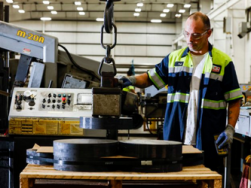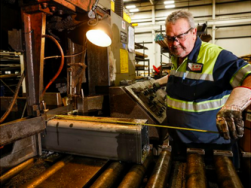State of Steel - February 2023
Pricing - Could we be seeing some stability?
Steel pricing seems to have leveled off in recent weeks and even crept upward slightly as high-cost inventories get depleted and lower-cost inventories hit distributor's floors. We are still seeing a large price gap between mechanical tubing and structural tubing, but it appears that the gap is shortening a little due to structural prices increasing and mechanical prices slightly decreasing. As of early February, structural tubing has seen two increases in 2023. These increases have created a floor and created some pricing stability.
While structural tube pricing remains low, mechanical tube pricing remains elevated and lead times stretch out beyond the 2nd and 3rd quarters of 2023. Due to availability constraints and limited producers, pricing looks to remain somewhat high. Most DOM, HRS and CDS prices are remaining flat and have been for months. Contract pricing has seen several increases due to continued inflationary pressures and the necessity to assure the sustainability of individual mills. No DOM Scrap Surcharge for the month of February 2023. DOM Fuel Surcharges dropped from 48% to 45% for the month of February.
The CRU index came in at $782/ton this week. Last week it was $770/ton. Week-over-week change is $12/ton. Looks like HRC is on a slow climb back up. We have now seen CRU increases since the beginning of the year. Cleveland-Cliffs announced a $50/ton spot price increase on HRC, CRC, and coated products, effective immediately, with Cleveland-Cliffs now setting the minimum base price for HRC at $850/ton. This is the 4th flat rolled products price increase announced by Cleveland-Cliffs since late November, collectively totaling $210/ton. Meanwhile, during that period, actual spot HRC prices have increased by $165/ton (prior to any impact from this new announcement). (Source: AMM)


Cast Iron Pricing
December did not see any base increases for cast iron. Dura-Bar’s base price has remained constant since April 1st of 2022. Surcharges appear to have hit bottom after 7 months in a row of decreases. February saw a small increase in all grades of cast iron making it two months in a row that we have seen subtle increases. The below chart details the Dura-Bar surcharges over the last year or so.

Scrap & Steel Inputs
Mills in Detroit kicked off the February scrap trade by offering to buy all grades of scrap at a $20/ton month-over-month increase (which was at the low end of expectations going into the week). This marks the 3rd consecutive month of higher scrap prices. Four Illinois dams that connect Lake Michigan with the Mississippi River will be closed between June 1 to September 30 for necessary maintenance. This 120-day closure will disrupt barge shipments and potentially have an impact on scrap and finished steel products from Canada to Texas and will likely put more stress on rail capacity. (Source: AMM)
Metal Production
In the week ended January 28, US raw steel production increased 0.9% week-over-week to 1,635,000 tons (-5.8% YoY). US capacity utilization was 73.1% vs 79.8% last year. This marks 29 consecutive weeks where capacity utilization has been below 80%. Year-to-date production is 6,452,000 tons down 7.0% year-over-year from 6,941,000 tons last year. (Source: AISI)
Lead Times
Understanding lead times for steel products are important to every participant in the supply chain. Lead times for steel products are as follows (as of 02/09/23):
Average HRC lead times increased last week to 5.0 weeks, which is below the average of 5.6 weeks since 2016. Other product lead times were flat to higher with CRC lead times at 6.7 weeks, HDG lead times at 7.3 weeks, and plate lead times at 4.9 weeks. (Source: Platts)
DOM Tubing lead times continue to be long but have shortened slightly and are now anywhere from 12 to 20 weeks. HRS and CDS tubing are substantially longer due to a lack of steel tube hollows and a short supply of raw materials. The long lead times are due to backlog, supply issues, contract business, and labor shortages.
Structural Tubing mill lead times are shortened and run approximately 2-4 weeks upon receipt of the order. Common sizes we can get sooner for now.
Dura-Bar Continuous Cast Iron mill lead times are approximately 2-4 weeks depending on size, grade, and finish. If it’s a large bar, special grade, size, or shape then the lead time could be considerably longer.
Oil & Gas Industry
The US rig count was flat week-over-week at 771 rigs as of 1/27. The rig count is up 26.4% year-over-year (Source: Baker Hughes). Brent Crude oil price per barrel of oil sits at $85.09 as of 2/09/23.
Imports/Exports
Evraz announced that more than 100 workers will be temporarily laid off at its operations in Regina, Saskatchewan, and more than 30 employees will be impacted in Camrose, Alberta. The company said it is taking these actions due to high volumes of low-priced imports. (Source: SMU) Imports into the US look to be increasing to start 2023 but are still predicted to be fairly low historically speaking.

Economic Factors
January’s manufacturing PMI fell to 47.4%, down from 48.4% in December, and the lowest level since May 2020 when the pandemic recovery began. (Source: SMU)
The US Federal Reserve increased its policy rate by 25 basis points to a range of 4.50-4.75%. (Source: Wall Street Journal) The Federal Reserve’s monetary policy tightening is getting traction, and the GDP numbers show that the Fed’s interest rate hikes are having their desired effect.
Employment / Hiring
Approximately 0.183 million Americans filed for unemployment insurance last week, which is the lowest since April 2022. This was better than economists’ expectations of 0.200 million claims and better than last week’s unrevised claims number of approximately 0.186 million claims. Continuing claims decreased slightly during the week ending January 21 (continuing claims have a week lag in terms of reporting) and stand at approximately 1.655 million continuing claims. (Source: Yahoo)






